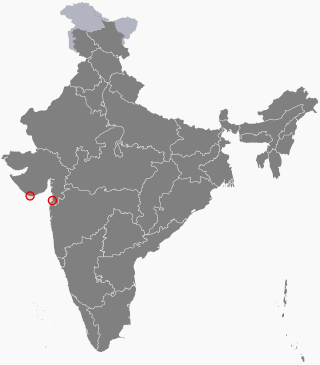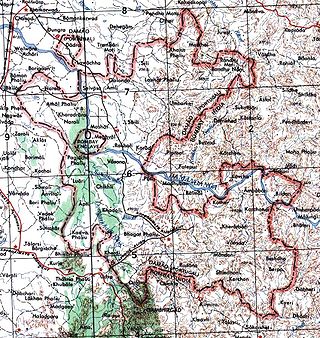This article may be confusing or unclear to readers.(December 2024) |
Many parts of Western and Northern regions of the Indian subcontinent were ruled as sovereign or princely states by various clans of Kolis.
Contents

This article may be confusing or unclear to readers.(December 2024) |
Many parts of Western and Northern regions of the Indian subcontinent were ruled as sovereign or princely states by various clans of Kolis.


Dadra and Nagar Haveli is a district of the union territory of Dadra and Nagar Haveli and Daman and Diu in western India. It is composed of two separate geographical entities: Nagar Haveli, wedged in between Maharashtra and Gujarat states 1 kilometre (0.62 mi) to the north-west, and the smaller enclave of Dadra, which is surrounded by Gujarat. Silvassa is the administrative headquarters of Dadra and Nagar Haveli.

Daman and Diu was a union territory in northwestern India. With an area of 112 km2 (43 sq mi), it was the smallest administrative subdivision of India on the mainland. The territory comprised two districts, Daman and Diu island, geographically separated by the Gulf of Khambat. The state of Gujarat and the Arabian Sea bordered the territory. A Portuguese colony since the 1500s, the territories were taken by India with the Annexation of Goa in 1961. Daman and Diu were administered as part of the union territory of Goa, Daman and Diu between 1961 and 1987. After the Goa Opinion Poll, they became a separate union territory. In 2019, legislation was passed to merge the union territory of Daman and Diu with its neighbouring union territory, Dadra and Nagar Haveli, to form the new union territory of Dadra and Nagar Haveli and Daman and Diu with effect from 26 January 2020.

Silvassa is a city and the headquarters of the Dadra and Nagar Haveli district in Union territory of Dadra and Nagar Haveli and Daman and Diu in western India. It is today the largest city in the union territory. The city was chosen as one of the hundred Indian cities in Government of India's flagship Smart Cities Mission.

The Daman Ganga, also called the Dawan River, is a river in western India. The river's headwaters are on the western slope of the Western Ghats range, and it flows west into the Arabian Sea. The river flows through Maharashtra and Gujarat states, as well as the Union territory of Dadra and Nagar Haveli and Daman and Diu. The industrial towns of Vapi, Dadra and Silvassa lie on the north bank of the river, and the town of Daman occupies both banks of the river's mouth.
Daman and Diu Lok Sabha constituency is one of the two Lok Sabha constituencies in the union territory of Dadra and Nagar Haveli and Daman and Diu in western India. This constituency came into existence in 1987, following the implementation of the Goa, Daman, and Diu Reorganisation Act, 1987.
Daman district, is one of four districts of the Indian union territory of Dadra and Nagar Haveli and Daman and Diu. It is located on the west coast of India and is surrounded by the Valsad district of the Gujarat state to the north, east and south, and by the Arabian Sea to the west. The district covers an area of 72 square kilometers and had a population of 191,173 as of the 2011 census, an increase of 69.256% from the 2001 census. The district headquarters is Daman. Previously, the territorial headquarters were in Panjim when it was jointly administered as Goa, Daman, and Diu until the time of the Konkani language agitation.

Diu district is one of the three districts of the union territory of Dadra and Nagar Haveli and Daman and Diu of India. The district is made up of Diu Island and two small enclaves of Simbor and Gogola, at the border with the state of Gujarat. The district headquarters are at Diu Town. It is the ninth least populous district in the country.
The Delhi, Andaman and Nicobar Islands, Lakshadweep, Daman and Diu and Dadra and Nagar Haveli (Civil) Services, abbreviated DANICS and formerly called the Delhi, Andaman and Nicobar Islands Civil Service is the civil service of the Union Territories of India. It is part of the Central Civil Services (CCS).

The annexation of Dadra and Nagar Haveli was the conflict in which the territories of Dadra and Nagar Haveli passed from Portuguese rule to independent rule, with Indian allegiance, in 1954.

A union territory is a type of administrative division in the Republic of India. Unlike the states of India, which have their own governments, union territories are federal territories governed, in part or in whole, by the Union Government of India. There are currently eight union territories in India: Andaman and Nicobar Islands, Chandigarh, Dadra and Nagar Haveli and Daman and Diu, Delhi (NCT), Jammu and Kashmir, Ladakh, Lakshadweep and Puducherry.
The Tenth Amendment of the Constitution of India, officially known as The Constitution Act, 1961, incorporated Dadra and Nagar Haveli as the seventh Union territory of India, by amending the First Schedule to the Constitution. It also amended clause (1) of article 240 of the Constitution to include therein the Union territory of Dadra and Nagar Haveli in order to enable the President to "make regulations for the peace, progress and good government of the territory". The 10th Amendment retroactively came into effect on 11 August 1961.
The Baria Koli, or Baraiya Koli, Bareeya Koli and Bariya Koli is a clan of the Koli caste found in the Indian State of Gujarat and Dadra and Nagar Haveli and Daman and Diu. the Devgad Baria was their Stronghold or given their name to Baria State in Gujarat.

Dadra and Nagar Haveli and Daman and Diu is a union territory in India. The territory was constituted through the merger of the former territories of Dadra and Nagar Haveli and Daman and Diu. Plans for the proposed merger were announced by the Government of India in July 2019; the necessary legislation was passed in the Parliament of India in December 2019 and came into effect on 26 January 2020. The territory is made up of four separate geographical entities: Dadra, Nagar Haveli, Daman, and the island of Diu. All four areas were formerly part of Portuguese India, with a joint capital at Panjim, Goa. They came under Indian rule in the mid-20th century after the Annexation of Goa and of the Free Dadra and Nagar Haveli. Goa, Daman and Diu were jointly administered until 1987, when Goa was granted statehood after the Konkani language agitation. The current capital is Daman and Silvassa is the largest city.
The Maharaja Soma Shah was Koli ruler of the petty kingdom of Ramnagar, present days in Gujarat. He invented the Chauth system which was a form of the Protection fees.
The first case of the COVID-19 pandemic in India was reported on 30 January 2020, originating from China. Slowly, the pandemic spread to various states and union territories including the union territory of Dadra and Nagar Haveli and Daman and Diu. The first case was recorded in this region on 10 April 2020.

The Administration of Dadra and Nagar Haveli and Daman and Diu is the governing body of the union territory of Dadra and Nagar Haveli and Daman and Diu. The administration is led by an administrator appointed by the President of India. The union territory doesn't have an elected legislative assembly. It governs three districts.
{{cite book}}: CS1 maint: location (link)